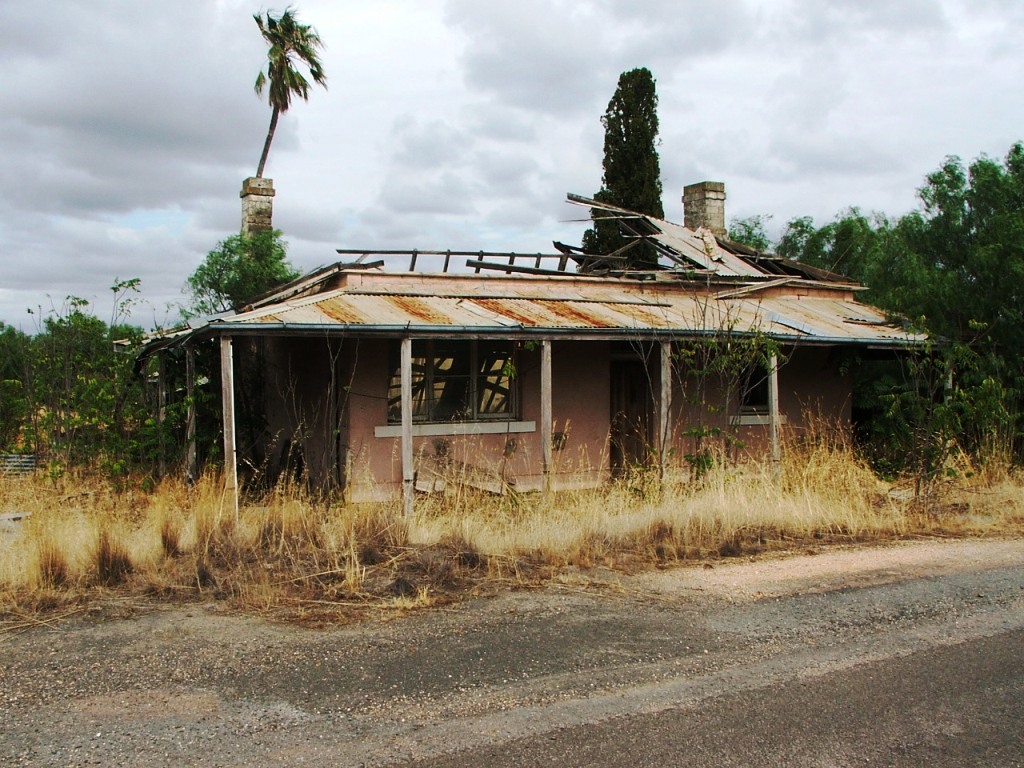
Napthali Ingham's Quarry Hotel, Ingham Road, Axedale, 1990 - Barry Palmer.

Ruins of Napthali Ingham's Quarry Hotel, Ingham Road, Axedale, 2013 - Kevin Crockett.
Who was Napthali Ingham?
Napthali Ingham was the son of .. and .. He arrived in Victoria from Lancashire, England, some time before 1860, and settled in Brunswick, Victoria. He may have been building his home in Ewen[sic] Street in 1860, at approximately 31 years of age, when he placed two advertisements in The Argus, October 10. One called for tenders for carting "upwards of 100 perches of rubbish to Sandridge." The other calls for tenders to supply "800 bushels of Geelong Roche Lime." His address, given for the purpose of the advertisements, is Ewen Street, Brunswick.
There were a number of quarries and clay pits in Brunswick at this time and by July 9, 1861, Ingham was operating a quarry and contracting services to local councils and boroughs for road works, including Sydney Road. He also operated the True Briton Hotel in Ewen Street.
Ingham continued his quarry works and business dealings in the Brunswick area for a few years and, around 1872, was contracting for the City of Bendigo. He eventually moved to Axedale, between Bendigo and Heathcote, where he took up land and opened a bluestone quarry on the east bank of the Campaspe River. As he had difficulty transporting bluestone to Bendigo, he wrote a letter to The Bendigo Advertiser, suggesting a tramway be laid between Sandhurst (Bendigo) and Axedale. Over the next ten years or so, he modified this suggestion to a rail line connecting Sandhurst, Axedale and Heathcote to the North East line at Seymour. This suggestion did not materialise in its entirety, but it eventually resulted in what became the Wandong, Heathcote and Sandhurst Rail Line, the first sections, Bendigo-Heathcote and Wandong-Kilmore, opening October 1, 1888.
In the 1870s, Ingham built the Quarry Hotel which is now the crumbling ruins adjoining Ingham Road on the east side of the Campaspe River and pictured above in 2013. Its condition is worsening as time passes.
Ingham intended to have a tramline constructed from his Axedale bluestone quarry to the new rail line. This also did not happen but he was successful in getting a wood siding provided at the location that is today's Hanson's Quarry.
Ingham died in 1909 and the rail line that grew out of his suggestion lasted until 1958 when it was closed from Bendigo to Heathcote. The Heathcote to Heathcote Junction section was closed in 1968.
During research for this collection, I became puzzled about a number of things: (1), I had two Ingham's - Napthali and John and references to both of them being involved in the quarry business at various times; (2), I had reference to an old building on Ingham's Hill, Axedale, as being Ingham's Hotel and, elsewhere, as Deane's Hotel; (3), I had indications that, when John Ingham died, Mr. V.A Deane appeared and was involved in the same activities and at the same places as Mr. Ingham. Further research around these points eventually gave clarification.
1 - The Births, Deaths and Marriages Index did not show the death of a John Ingham in 1909. However, the details shown in the above obituary, are identical in every way with the BDM Index details for Napthali Ingham. That tells me that they were one and the same or, if you like, Napthali was commonly known as John - if the name John was correctly used.
2 - Napthali Ingham owned Ingham's Quarry Hotel on Ingham Road, Axedale, when he died in 1909. He was survived by his wife, Mary Ann [nee Cheshire] and a daughter. The daughter is Alice Louisa. Alice married Victor Allen Deane in Toorak in 1909 and they would have come to Axedale, to her mother, Mary Ann, at what was then Ingham's Quarry Hotel. In other words, from 1909, the Deane's, and Alice's mother, were living at the Hotel from that time, although I suspect that they later moved to Deane's property. There is the connection to both the Ingham's Hotel and Deane's Hotel names. Mary Ann Ingham died in 1920 at Axedale.
3 - As Victor Allen Deane was Napthali Ingham's son-in-law, it is not unreasonable to assume that he should 'inherit' or take on, the quarrying and contracting activities that Napthali Ingham had been pursuing up to his death. Victor died in Bendigo at the age of 70 in 1948.
The information contained here has been culled from newspaper articles, Victorian Railways information and other historical sources.